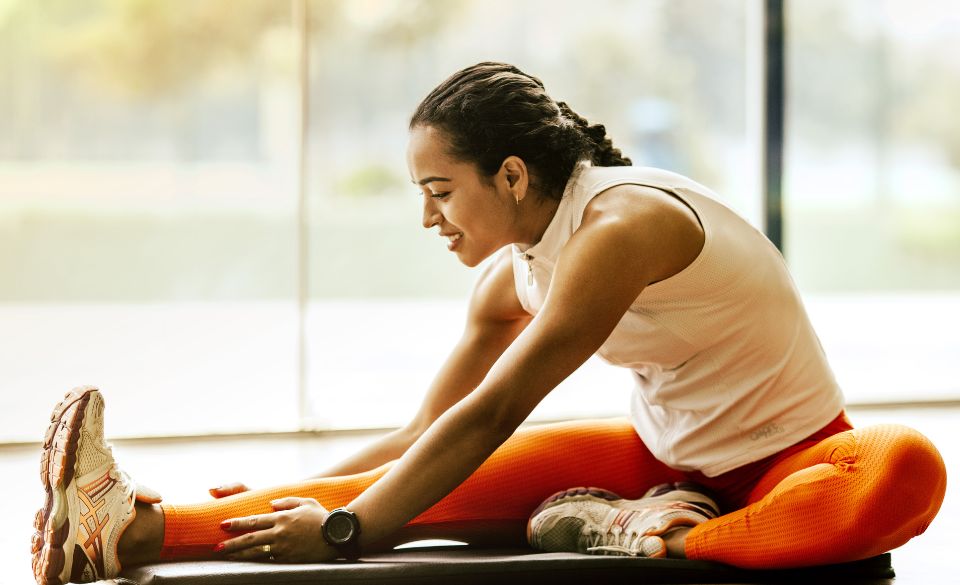
10 Best Glute Stretches For Runners
Page Contents
- Understanding the Glute Musculature
- Advantages of Incorporating Glute Stretches
- Dynamic Glute Stretches
- Leg Swings
- Glute Bridge
- Side Lunges
- Lateral Band Walks
- Bodyweight Squats
- Static Glute Stretches
- Standing Knee-to-Chest Stretch
- Lying Figure Four Stretch
- Seated Spinal Twist
- Downward Facing Dog
- Pigeon Pose
- Final Words – Glute Stretches For Runners
Discover the most effective glute stretches to engage your buttock muscles, whether it’s as a prelude to your workout or as a post-exercise routine. These stretches prove invaluable for individuals grappling with tight glutes resulting from strength training or those seeking to activate their glutes before a run. As a seasoned trainer, I’ve curated a selection of top-tier stretches tailored to your needs. The stretches are categorized into two distinct types: dynamic and static stretches. Dynamic stretches incorporate movement and are ideal for inclusion in your warm-up routine, while static stretches involve holding specific positions to target the glutes, making them the perfect choice for your post-workout recovery.
Understanding the Glute Musculature
To fully appreciate the significance of glute stretches, it’s advantageous to begin with a brief exploration of the gluteal muscles. The gluteal muscles are comprised of three primary components: the gluteus maximus, the gluteus medius, and the gluteus minimus. The gluteus maximus, representing the largest segment, predominantly occupies the gluteal region. Positioned on the upper exterior of each side of the glutes, the gluteus medius contributes to hip movement, while the gluteus minimus, in close proximity to the gluteus medius, aids in stabilizing the hips.
The pivotal role of your gluteal muscles extends beyond mere anatomical knowledge. They play a crucial part in fostering proper running form and elevating athletic performance across various sports and fitness endeavors. Notably, the gluteus maximus, as the body’s most expansive muscle, yields multifaceted benefits, including the potential to enhance athletic prowess, augment the quality of daily life, and facilitate increased caloric expenditure compared to exercises targeting smaller muscle groups.
Advantages of Incorporating Glute Stretches
Embracing glute stretches offers a spectrum of advantages tailored to address an array of concerns. These benefits encompass:
– Alleviation of Gluteal Muscle Tension.
– Enhanced Range of Motion.
– Mitigation of Lower Back Discomfort.
– Reduction of Hip Tightness.
– Diminished Susceptibility to Injuries.
Dynamic Glute Stretches
Dynamic stretches encompass movement-based techniques that allow for the full extension of your muscles. They serve as a valuable component of a warm-up routine, priming your body for subsequent exercises. The following dynamic glute stretches are particularly effective in alleviating tension in tight glute muscles and preparing the body for activities like running and lower body weight training:
Leg Swings
Leg swings can be seamlessly integrated into your warm-up regimen. If you require additional support for balance, position yourself near a wall, tree, or a sturdy chair.
Execution:
– Begin with your feet at hip-width apart.
– Lift one leg and swing it from side to side in front of your body, completing 10 leg swings.
– Rotate and swing your leg from front to back, repeating the sequence for 10 swings.
– Repeat the entire process for the other leg, performing two sets on both sides.
Glute Bridge
The glute bridge represents a versatile exercise for stretching and strengthening the glute muscles. It can be executed anywhere without the need for specialized equipment.
Execution:
– Lie on your back with your knees bent and feet resting on the floor.
– Engage your glutes and elevate your hips off the floor until your body forms a straight line from collarbone to knees.
– Lower your body back to the ground without holding any part of the movement, ensuring that it remains dynamic.
– Perform 2 sets of 10 glute bridges.
Side Lunges
Side lunges are among the most effective glute stretches for releasing tension in the hip area and smaller glute muscles positioned on the sides of the gluteus maximus.
Execution:
– Stand with your feet positioned shoulder-width apart, ensuring your head and chest remain upright and your core muscles are engaged.
– Step sideways with one leg, keeping your body and feet oriented forward.
– Return to the center position.
– Sidestep with the other leg.
– Continue this dynamic stretch, completing 10 steps on each side.
– Perform 2 sets of 10 side lunges.
Lateral Band Walks
Lateral band walks encompass dynamic stretching while concurrently fortifying the glutes and hips. A resistance band is the sole equipment needed for this exercise.
Execution:
– Position a resistance band above your knees, encircling your thighs.
– Stand with your feet at hip-width, knees slightly flexed.
– Maintain forward-facing alignment of your head, knees, and body, taking side steps.
– As you sidestep, the resistance band should experience tension.
– Execute 10 steps to one side before repeating the sequence in the opposite direction.
– Perform 2 sets of 10 lateral band walks.
Bodyweight Squats
Bodyweight squats are an excellent preliminary exercise for lower-body workouts, effectively activating your glute muscles for running or strength training.
Execution:
– Position your feet approximately hip-width apart, engaging your core muscles.
– Initiate a squat motion, lowering your body and bending your knees, akin to sitting in an invisible chair.
– Return to a standing position.
– Perform 2 sets of 10 bodyweight squats.
Static Glute Stretches
Static glute stretches are most effective when performed after a workout when your muscles are adequately warmed up. These stretches serve to alleviate muscle soreness, mitigate tightness, and release tension in your glutes.
Standing Knee-to-Chest Stretch
The standing knee-to-chest stretch is a widely favored static glute stretch that can be effortlessly executed without the need for any equipment.
Execution:
– Begin by standing with your feet at hip-width apart.
– Raise one leg, bending at the knee, and bring your thigh upward towards your chest.
– Grasp your leg with both hands as you draw it closer to your chest.
– Hold this stretch for 20 seconds.
– Repeat the sequence with the other leg.
– Perform two sets of stretches for each leg.
Lying Figure Four Stretch
This static glute stretch facilitates a deep stretch on each side of your glutes.
Execution:
– Commence by lying on your back with your knees bent and feet flat on the floor.
– Position your left ankle atop your right thigh, just above the knee.
– Elevate your right foot off the ground and draw your right knee towards your chest. Hold your right knee as you draw it closer to you.
– To intensify the stretch, you may choose to grip the back of your thigh rather than your knee, or lift your lower leg into the air for a more profound stretch.
– Maintain this position for 20 seconds.
– Repeat the same stretch on the other side.
– Execute two sets on each side.
Seated Spinal Twist
The seated spinal twist is a comprehensive stretch that targets the glutes, back, hips, and abs.
Execution:
– Initiate this stretch from a seated position, with your legs extended in front of you on the floor.
– Bend your left knee and position your left foot on the outside of your right leg.
– Elevate your right arm and rotate your body, ensuring that your right arm rests on the exterior of your left leg.
– Breathe and sustain the twist for a duration of 20 to 30 seconds.
– Return to the initial position and replicate the stretch on the other side.
– Perform two sets on each side.
Downward Facing Dog
The classic yoga pose, Downward Facing Dog, provides an excellent lower body stretch, targeting the glutes, hamstrings, and calves.
Execution:
– Initiate the pose on your hands and knees, with your hands shoulder-width apart, firmly planted on the floor.
– Straighten and elevate your knees, creating an inverted V shape with your body.
– Engage your hands and feet to elongate your body.
– Hold this pose for a duration of 20 to 30 seconds.
– Repeat as needed.
Pigeon Pose
The yoga pigeon pose is a quintessential glute stretch that also serves to release tension in your hips and back.
Execution:
– Begin from a tabletop position on your hands and knees.
– Bend one leg and draw your knee out to the side, raising your shin towards your body.
– Extend your other leg straight back while keeping your hips facing forward.
– Elongate your spine and perceive the stretch in the bent leg and glute muscles on that side.
– Maintain this pose for 20 seconds before repeating.
– Repeat the same stretch on the opposite side.
– Perform two sets on each side.
Final Words – Glute Stretches For Runners
Incorporating glute stretches into your exercise routine can offer a multitude of benefits, whether you use them to prepare for a workout or as a post-exercise recovery regimen. These stretches are particularly useful for individuals dealing with tight glutes resulting from strength training or for those looking to activate their glutes before a run. As a seasoned trainer, I have carefully selected a range of top-tier stretches, categorized into dynamic and static stretches, to cater to your specific needs.
Understanding the Glute Muscles:
Before delving into the stretches, it’s essential to have a brief understanding of the gluteal muscles. Comprising the gluteus maximus, gluteus medius, and gluteus minimus, these muscles play a vital role in proper running form and athletic performance.
Advantages of Incorporating Glute Stretches:
The advantages of glute stretches include relieving muscle tension, improving range of motion, reducing lower back pain, alleviating hip tightness, and lowering the risk of injuries.
Dynamic Glute Stretches:
Dynamic stretches, characterized by movement, are ideal for warming up before exercises. These dynamic glute stretches are effective for releasing tension in tight glute muscles and preparing the body for activities like running and lower body weight training.
Static Glute Stretches:
Static glute stretches, best performed after a workout when your muscles are warm, aid in preventing muscle soreness, easing tension, and mitigating tightness in your glutes. These stretches target various areas and can be conveniently incorporated into your post-exercise routine.
Whether you choose dynamic or static glute stretches, integrating them into your workout routine can contribute to enhanced performance, reduced discomfort, and a lower risk of injury. So, get ready to unlock the potential of your glutes and elevate your fitness journey.




